CHEVROLET BLAZER 1997 2.G Owners Manual
Manufacturer: CHEVROLET, Model Year: 1997, Model line: BLAZER, Model: CHEVROLET BLAZER 1997 2.GPages: 402, PDF Size: 21.93 MB
Page 231 of 402
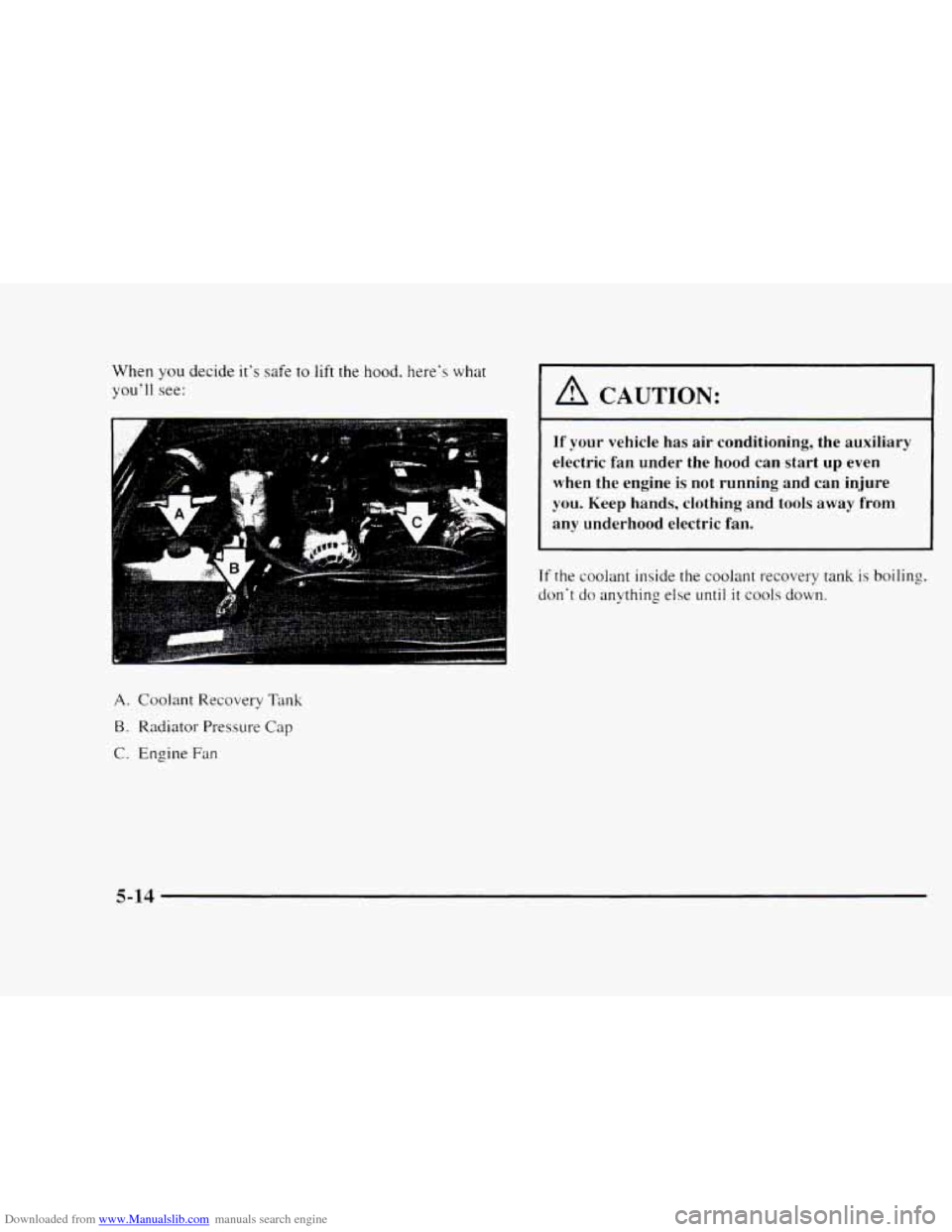
Downloaded from www.Manualslib.com manuals search engine When you decide it's safe to lift the hood. here's what
you'll see:
hi
A. Coolant Recovery Tank
B. Radiator Pressure Cap
C. Engine Fan
A CAUTION:
If your vehicle has air conditioning, the auxiliary
electric fan under the hood can start up even
when the engine is not running and can injure
you. Keep hands, clothing and tools away from
any underhood electric fan.
If the coolant inside the coolant recovery tank is boiling,
don't do anything else until it cools down.
5-14
Page 232 of 402
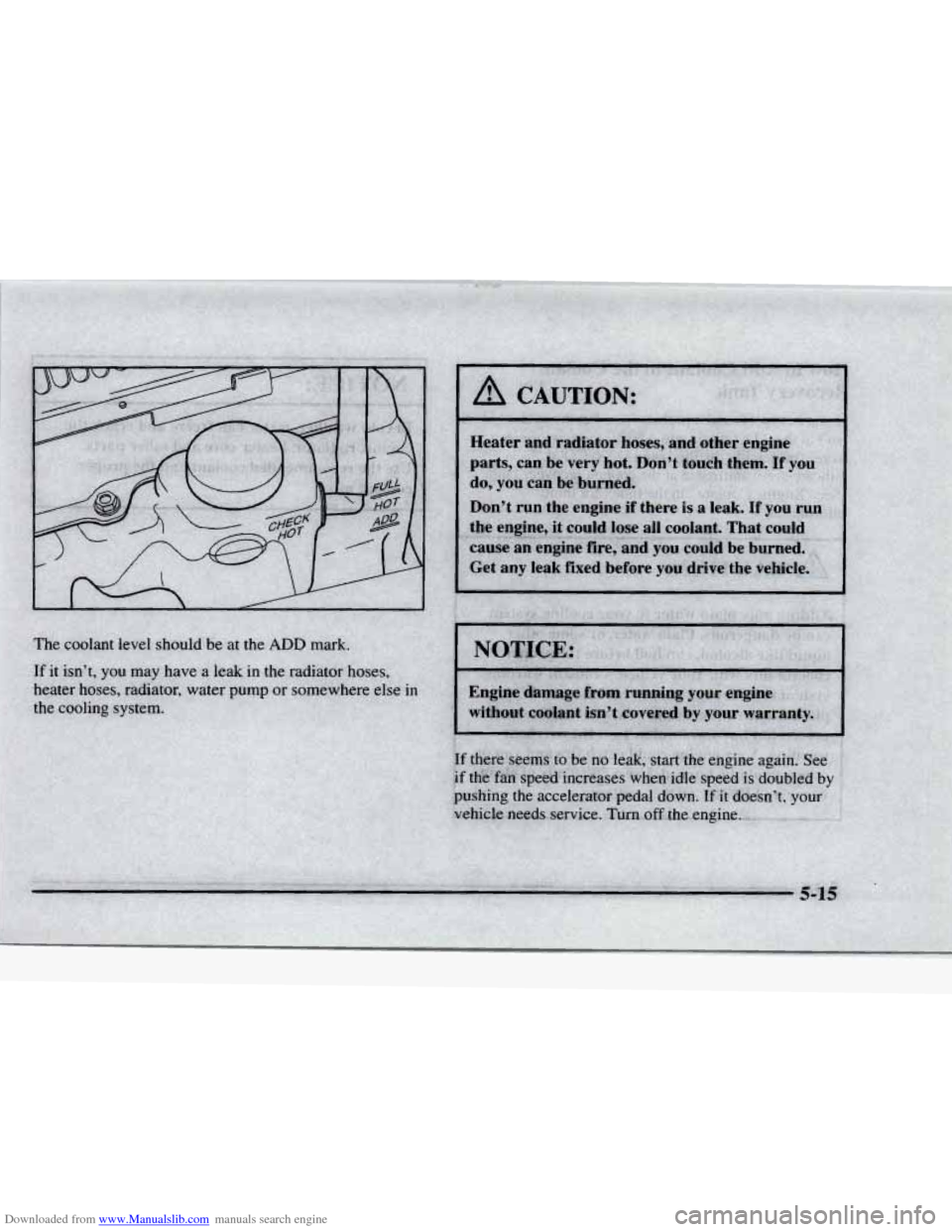
Downloaded from www.Manualslib.com manuals search engine The coolant level should be at the ADD mark.
If it isn’t, you may have a leak in the radiator h
heater hoses, radiator, water pump or somewhere else lr
wlw44l
A CAUTION:
Heater and radiator hoses, and other engine
parts, can be very hot. Don’t touch them.
If you
do, you can’be burned.
Don’t run the engine
if there is a leak. If you run
the engine,
it could lose all coolant. That could
cause
an engine fire, and you could be burned.
Get any leak fixed before you drive the vehicle.
Page 233 of 402
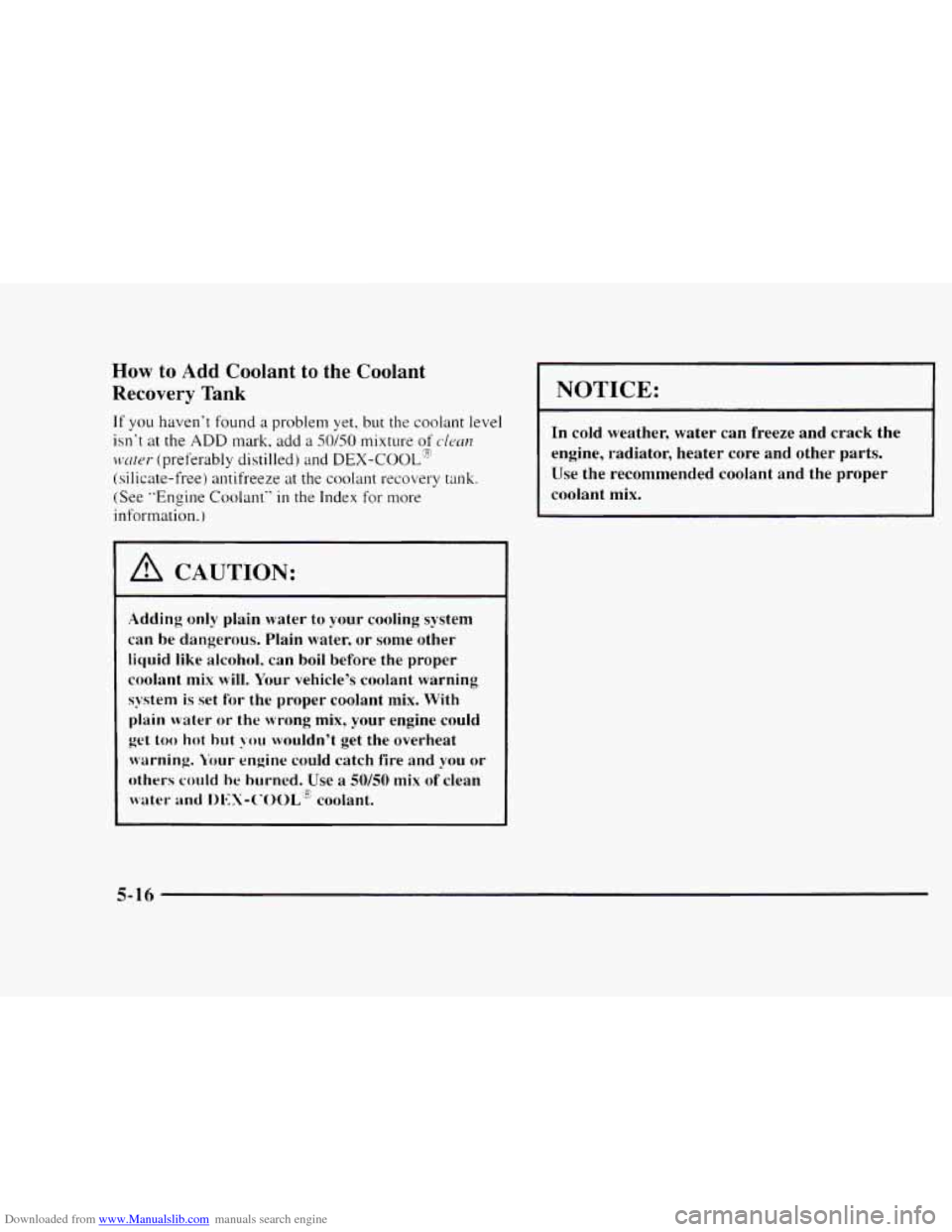
Downloaded from www.Manualslib.com manuals search engine How to Add Coolant to the Coolant
Recovery Tank
If you haven‘t found a problem yet, but the coolant level
isn‘t at the ADD mark, add a SO/SO mixture of clenrz
wter (preferably distilled) and DEX-COOL”
(silicate-free) antifreeze at the coolant recovery tank.
(See ”Engine Coolant”
in the Index for more
information.)
A CAUTION:
Adding only plain water to your cooling system
can be dangerous. Plain water, or some other
liquid like alcohol, can boil before the proper
coolant mix
will. Your vehicle’s coolant warning
system
is set for the proper coolant mix. With
plain water
or the wrong mix, your engine could
get too hot but >‘ou wouldn’t get the overheat
warning. k‘our
engine could catch fire and you or
others
could he hurned. Use a 50/50 mix of clean
water and DKX-CWOL” coolant.
NOTICE:
In cold weather, water can freeze and crack the
engine, radiator, heater core and other parts.
Use the recommended coolant and the proper
coolant
mix.
5-16
Page 234 of 402
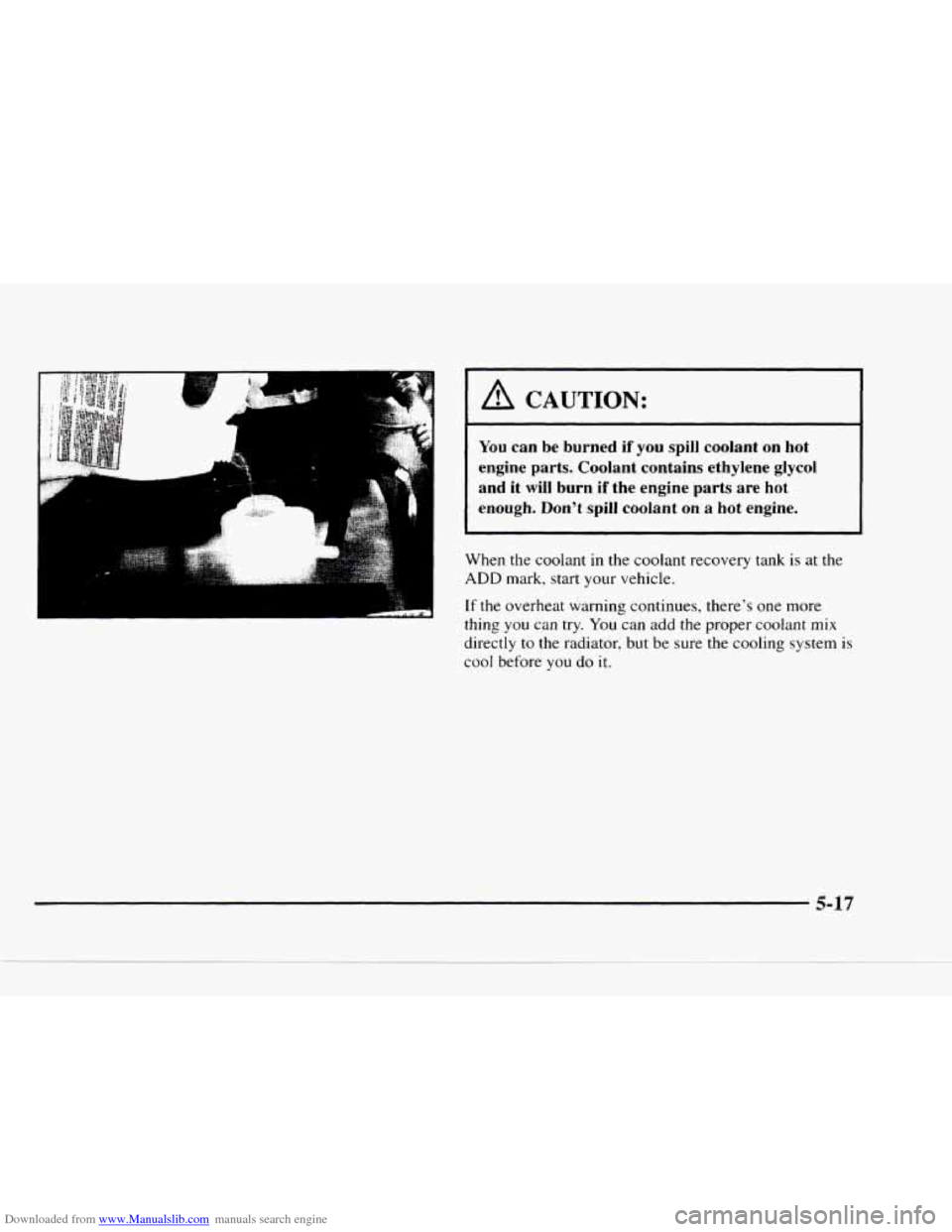
Downloaded from www.Manualslib.com manuals search engine 4
I A CAUTION:
You can be burned if you spill coolant on hot
engine parts. Coolant contains ethylene glycol
and it
will burn if the engine parts are hot
enough. Don’t spill coolant on
a hot engine.
When the coolant in the coolant recovery tank is at the
ADD mark, start your vehicle.
If the overheat warning continues, there’s one more
thing
you can try. You can add the proper coolant mix
directly to the radiator, but be sure the cooling system is
cool before you do it.
5-17
Page 235 of 402
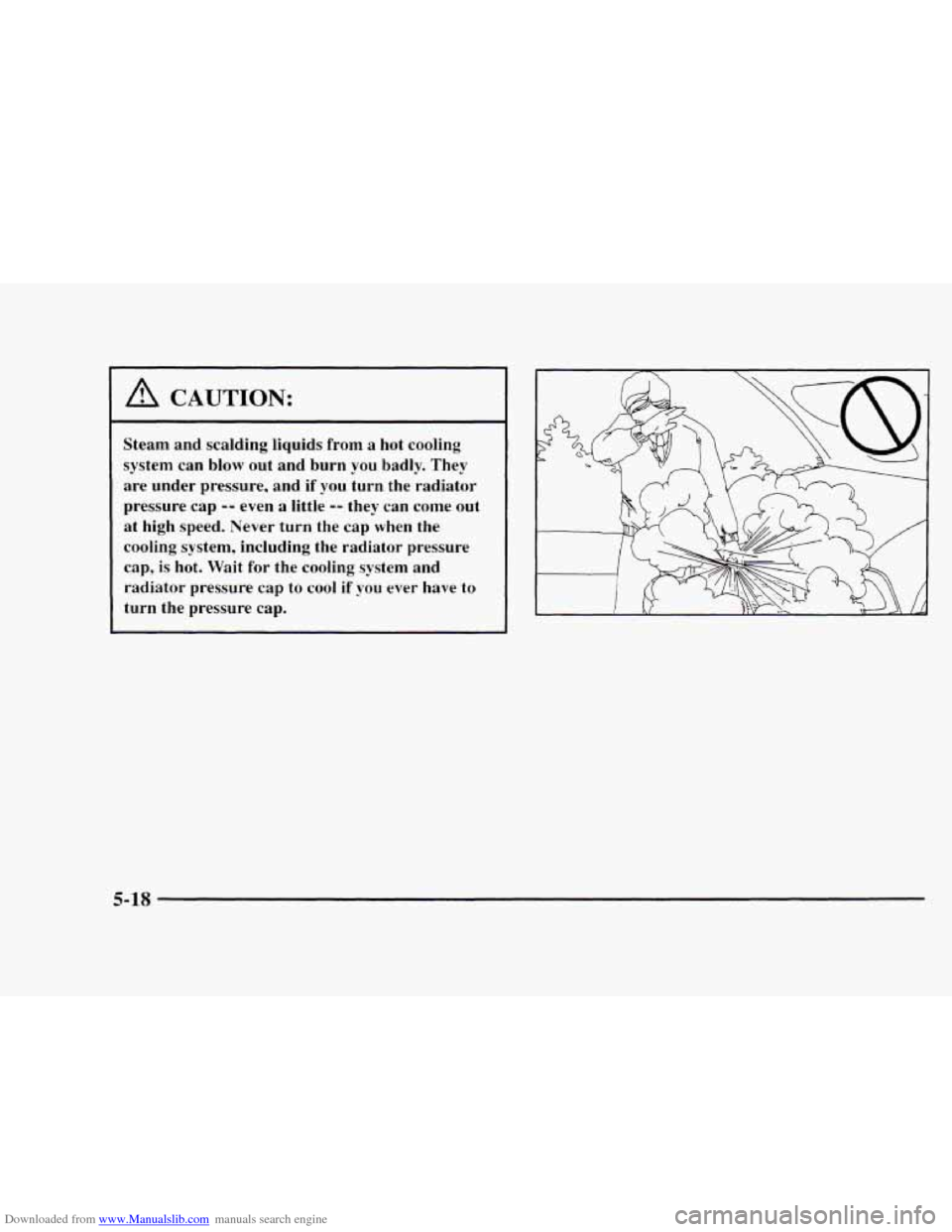
Downloaded from www.Manualslib.com manuals search engine A CAUTION:
Steam and scalding liquids from a hot cooling
system can blow out and burn you badly. They
are under pressure, and
if you turn the radiator
pressure cap
-- even a little -- they can come out
at high speed. Never turn the cap when the
cooling system, including the radiator pressure
cap,
is hot. Wait for the cooling system and
radiator pressure cap to
cool if you ever have to
turn the pressure cap.
5-18
Page 236 of 402
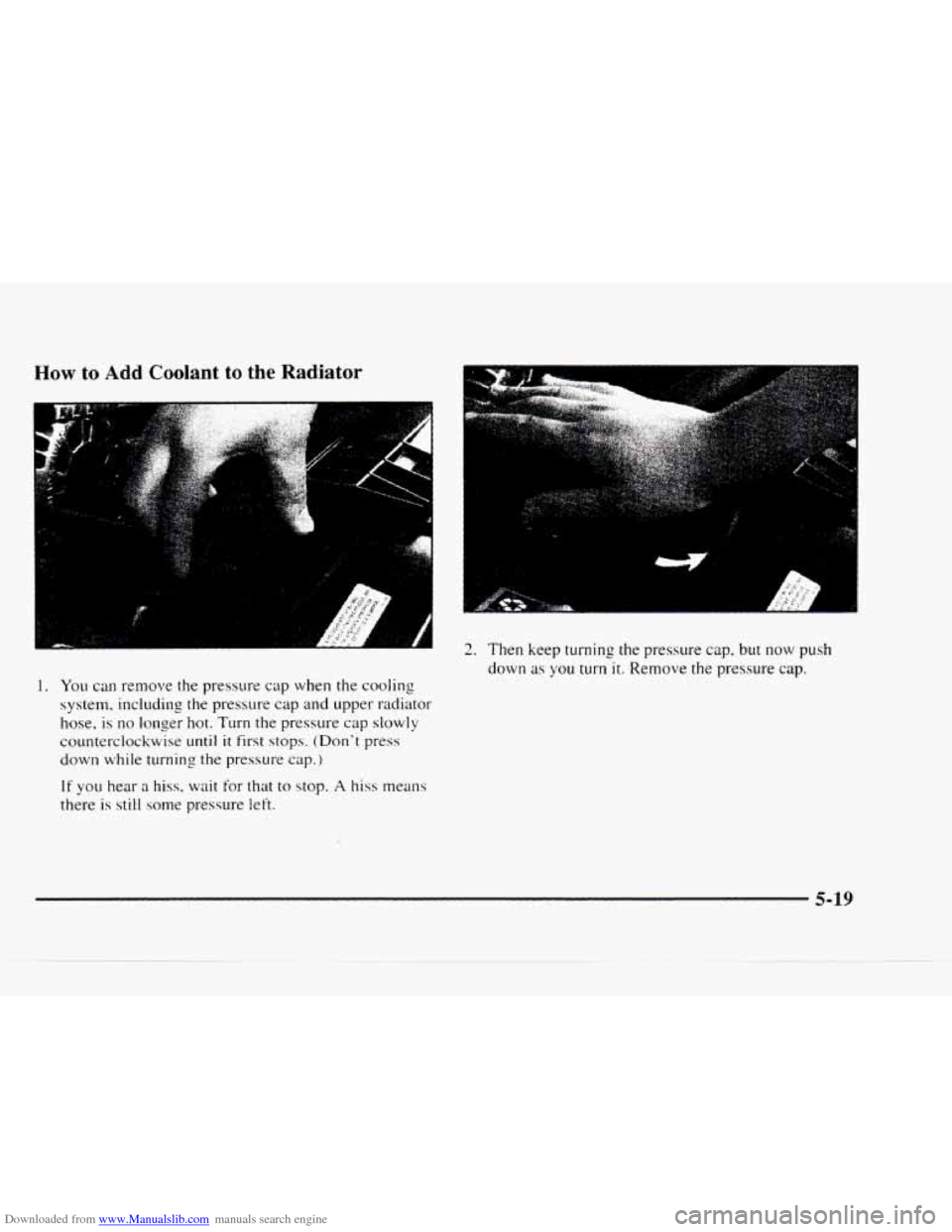
Downloaded from www.Manualslib.com manuals search engine How to Add Coolant to the Radiator
1. You can remove the pressure cap when the cooling
system, including the pressure cap and upper radiator
hose, is no longer hot. Turn the pressure cap slowly
counterclockwise
until it first stops. (Don't press
down while turning the pressure cap.)
If you hear a hiss. wait for that to stop. A hiss means
there is still some pressure left.
2. Then keep turning the pressure cap, but now push
down as you turn it. Remove the pressure cap.
5-19
Page 237 of 402
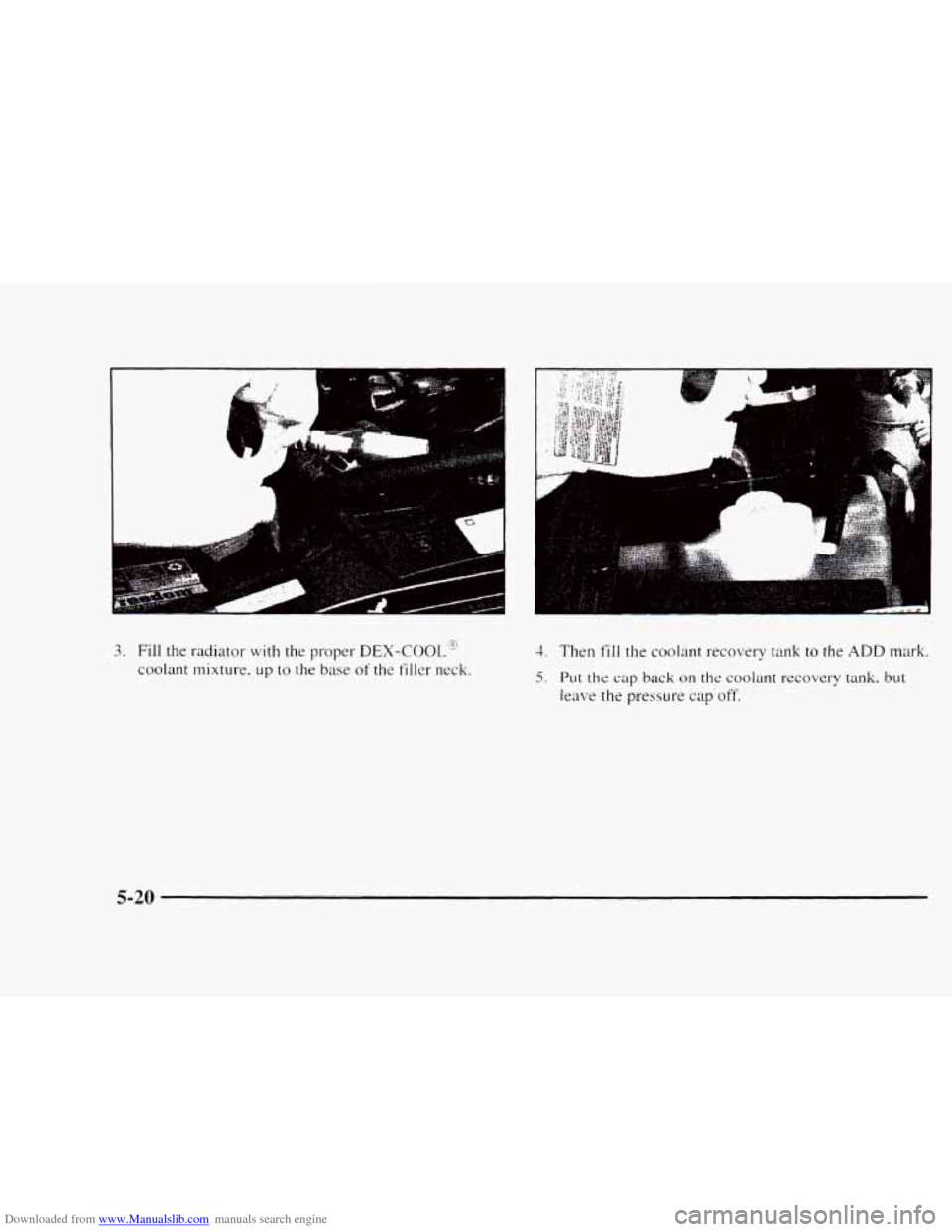
Downloaded from www.Manualslib.com manuals search engine 1
3. Fill the radiator with the proper DEX-COOL"
coolant mixture. up to the base of the filler neck.
3. Then fill the coolant recovery tank to the ,4DD mark.
5. Put the cap back on the coolant recovery tank. but
leave the pressure cap off.
5-20
Page 238 of 402
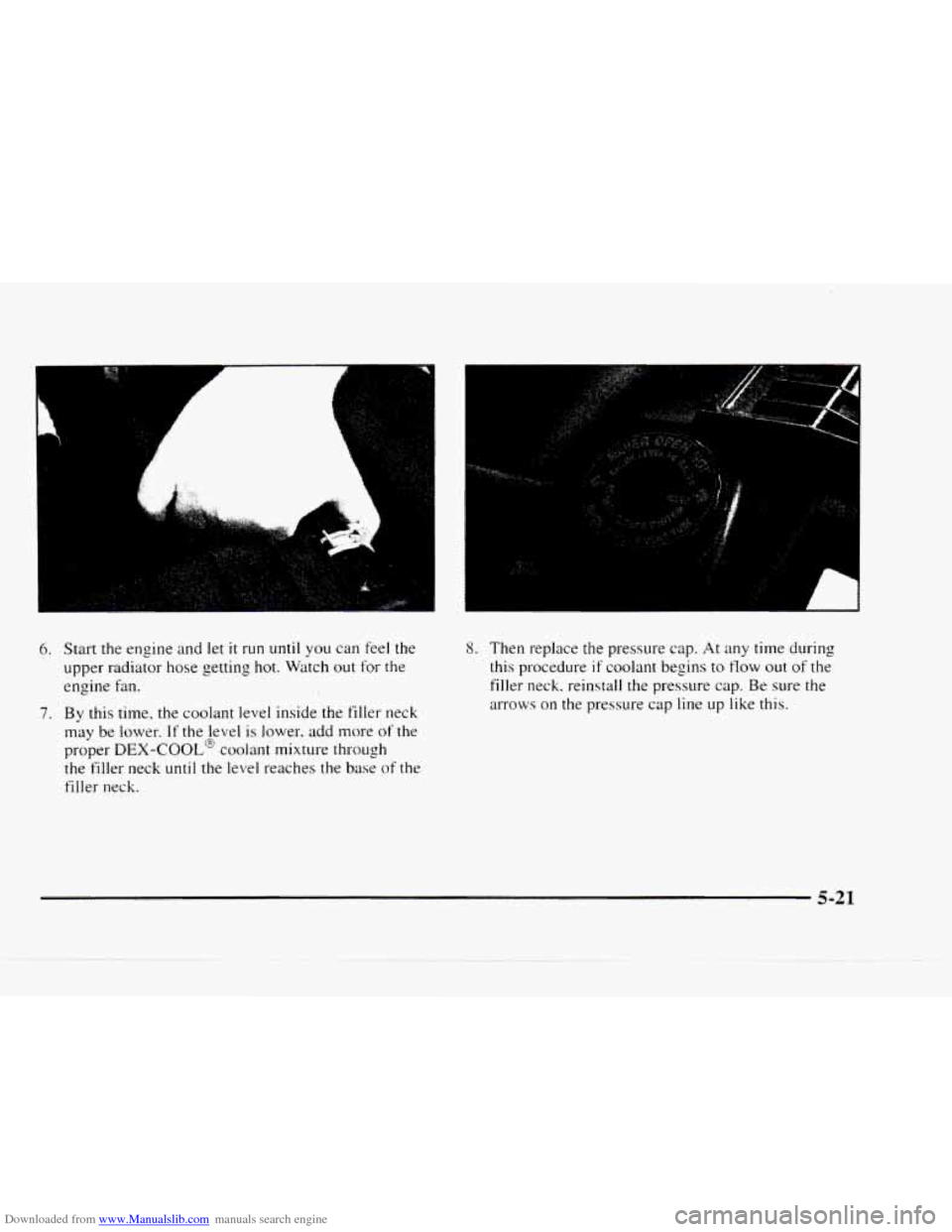
Downloaded from www.Manualslib.com manuals search engine A
6. Start the engine and let it run until you can feel the
upper radiator hose getting
hot. Watch out for the
engine fan.
7. By this time, the coolant level inside the filler neck
may be lower. If the Ievel is lower. add more of the
proper
DEX-COOL@ coolant mixture through
the filler neck
until the level reaches the base of the
filler neck.
8. Then replace the pressure cap. At any time during
this procedure
if coolant begins to flow out of the
filler neck, reinstall the pressure cap.
Be sure the
arrows
on the pressure cap line up like this.
5-21
Page 239 of 402
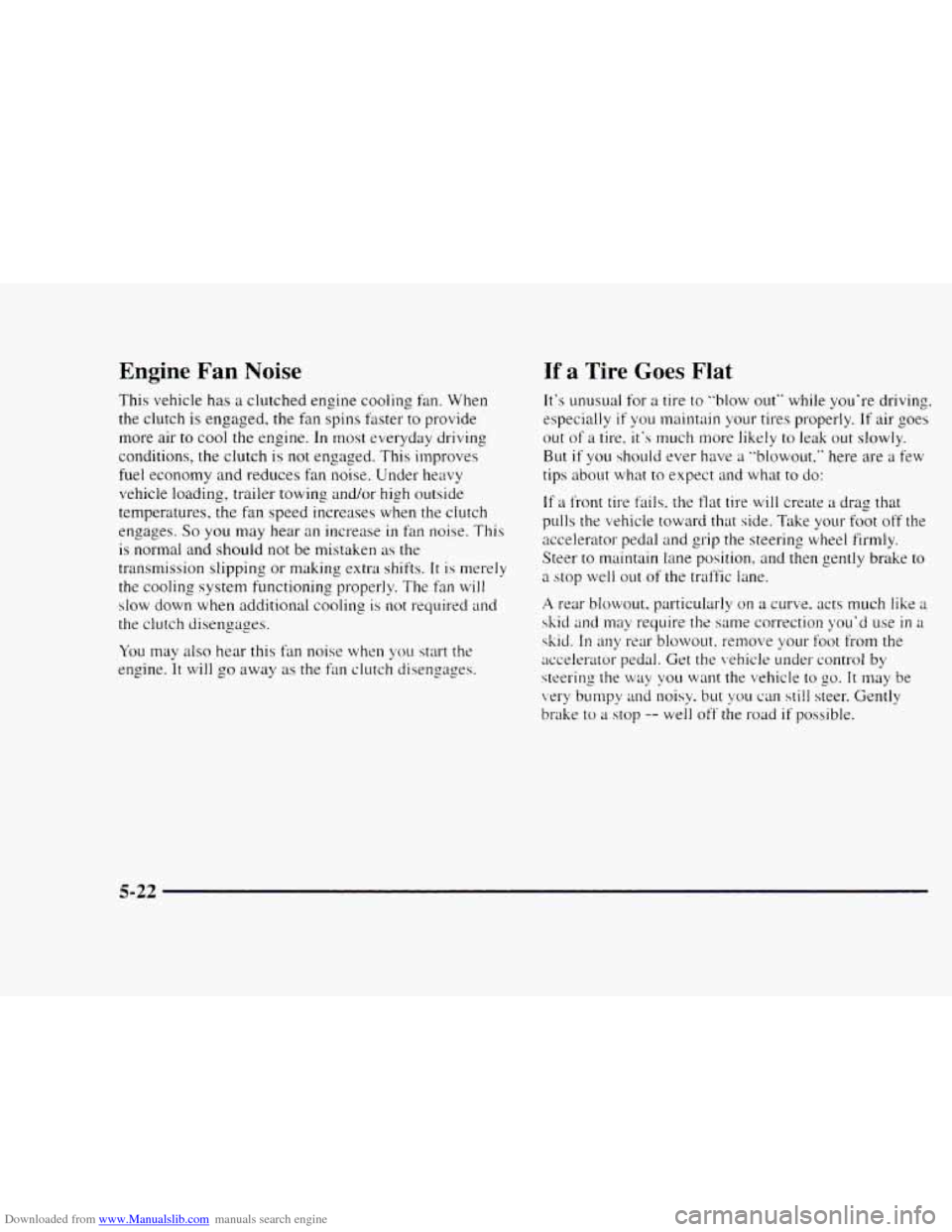
Downloaded from www.Manualslib.com manuals search engine Engine Fan Noise
This vehicle has a clutched engine cooling fan. When
the clutch
is engaged, the fan spins faster to provide
more air
to cool the engine. In most everyday driving
conditions, the clutch
is not engaged. This improves
fuel economy and reduces fan noise. Under heavy
vehicle loading, trailer towing and/or high outside
temperatures. the fan speed increases when the clutch
engages.
So you may hear an increase in fan noise. This
is normal and should
not be mistaken as the
transmission slipping or making extra shifts.
It is merely
the cooling system functioning properly. The
fa11 will
slow down when additional cooling is not required and
the clutch disengages.
You may also hear this fan noise when you start the
engine.
It will go away as the fan clutch disengages.
If a Tire Goes Flat
It's unusual for a tire to "blow out" while you're driving.
especially
if you maintain your tires properly. If air goes
out of a tire, it's much Inore likely to leak out slowly.
But if you should ever have ;I "blowout." here are a few
tips about what to expect and what to do:
If a front tire fails. the flat tire will create a drag that
pulls the vehicle toward that side. Take your foot off the
accelerator pedal and grip the steering wheel firmly.
Steer
to maintain lane position. and then gently brake to
a stop well out of the traffic lane.
A rear blowout. particularly on a curve. acts much like a
skid and may require the same correction you'd use in a
skid. In any rear blowout. remove your foot from the
xcelerator pedal. Get the \,chicle under control by
steering the way you want the vehicle to go. It may be
\.cry bunlpy and noisy. but you can still steer. Gently
brake
to a stop -- well off the road if possible.
5-22
Page 240 of 402
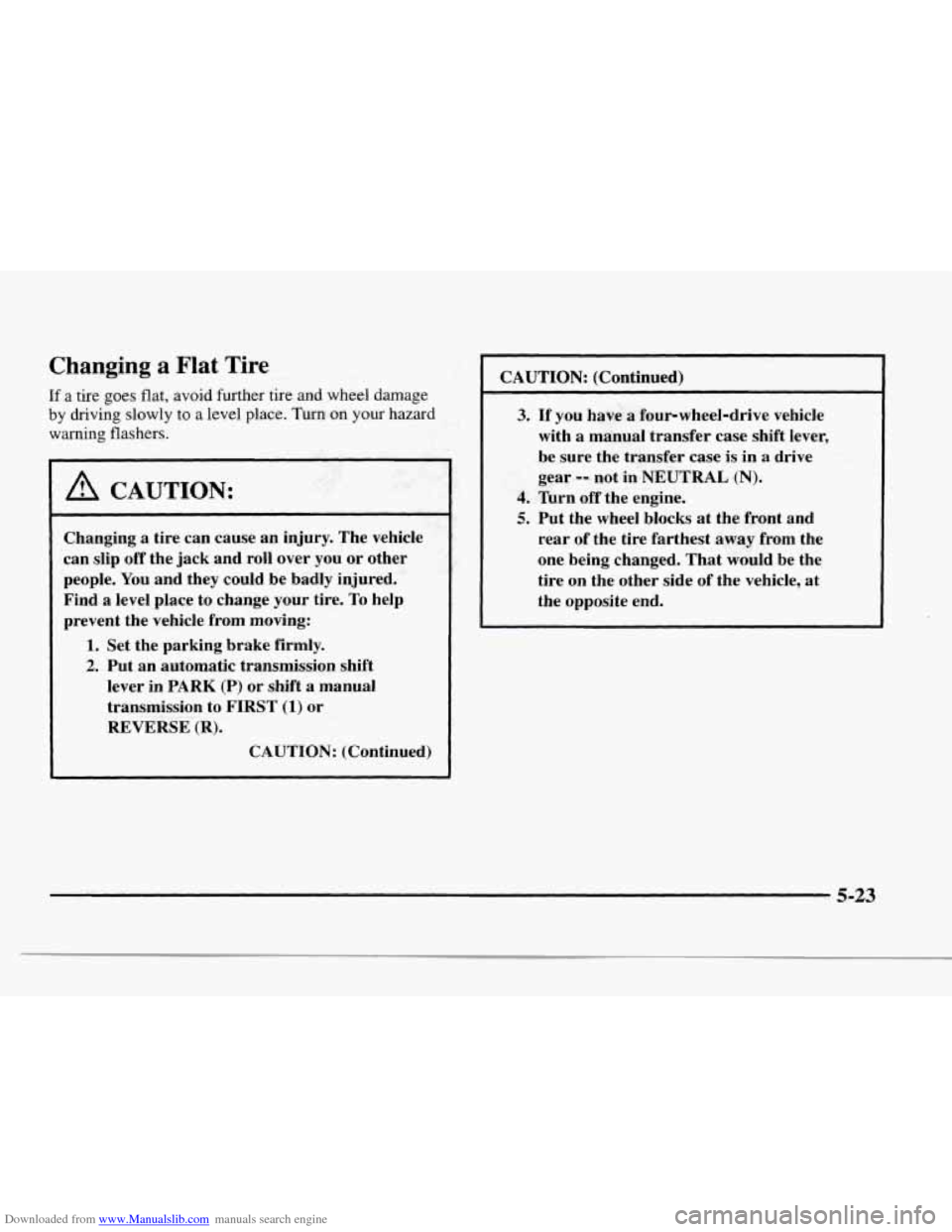
Downloaded from www.Manualslib.com manuals search engine Changing a Flat Tire
If a tire goes flat, avoid further tire and wheel damage
by driving slowly to a level
place. Turn on your hazard
warning flashers.
A CAUTION:
Changing a tire can cause an injury. The vehicle
can slip off the jack and roll over you or other
people.
You and they could be badly injured.
Find a level place to change your tire.
To help
prevent the vehicle from moving:
1. Set the parking brake firmly.
2. Put an automatic transmission shift
lever in PARK
(P) or shift a manual
transmission
to FIRST (1) or
REVERSE
(R).
CAUTION: (Continued)
CAUTION: (Continued)
3. If you have a four-wheel-drive vehicle
with a manual transfer case shift lever,
be sure the transfer case is in a drive
gear
-- not in NEUTRAL (N).
4. lbrn off the engine.
5. Put the wheel blocks at the front and
rear
of the tire farthest away from the
one being changed. That would be the
tire
on the other side of the vehicle, at
the opposite end.
5-23